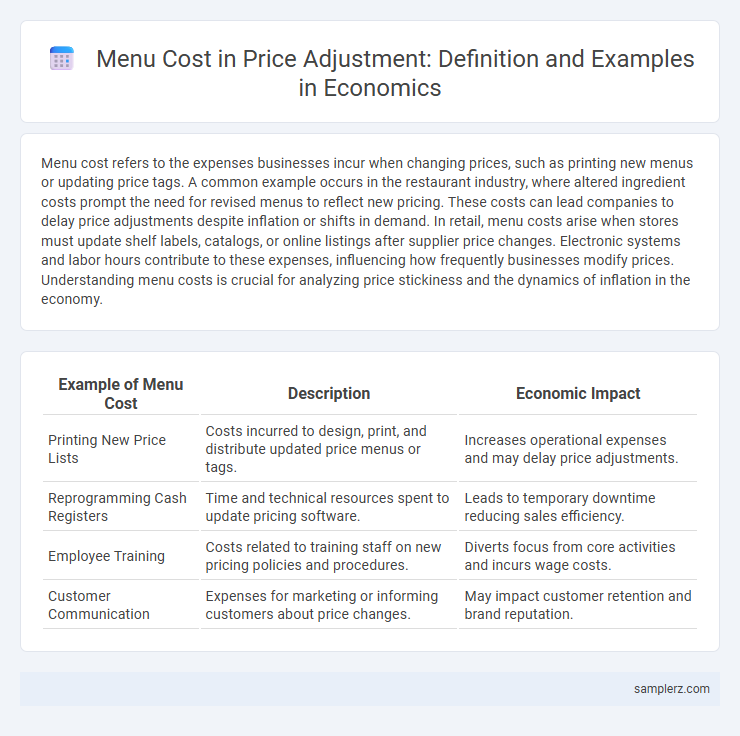Menu cost refers to the expenses businesses incur when changing prices, such as printing new menus or updating price tags. A common example occurs in the restaurant industry, where altered ingredient costs prompt the need for revised menus to reflect new pricing. These costs can lead companies to delay price adjustments despite inflation or shifts in demand. In retail, menu costs arise when stores must update shelf labels, catalogs, or online listings after supplier price changes. Electronic systems and labor hours contribute to these expenses, influencing how frequently businesses modify prices. Understanding menu costs is crucial for analyzing price stickiness and the dynamics of inflation in the economy.
Table of Comparison
| Example of Menu Cost | Description | Economic Impact |
|---|---|---|
| Printing New Price Lists | Costs incurred to design, print, and distribute updated price menus or tags. | Increases operational expenses and may delay price adjustments. |
| Reprogramming Cash Registers | Time and technical resources spent to update pricing software. | Leads to temporary downtime reducing sales efficiency. |
| Employee Training | Costs related to training staff on new pricing policies and procedures. | Diverts focus from core activities and incurs wage costs. |
| Customer Communication | Expenses for marketing or informing customers about price changes. | May impact customer retention and brand reputation. |
Understanding Menu Costs in Economic Theory
Menu costs represent the expenses firms incur when changing prices, such as printing new menus or updating digital price tags, impacting their responsiveness to market fluctuations. In economic theory, these costs create price rigidity, causing firms to delay adjustments despite shifts in demand or supply, which can contribute to market inefficiencies. Understanding menu costs helps explain why nominal prices often remain sticky, influencing inflation dynamics and monetary policy effectiveness.
Real-World Examples of Menu Costs in Retail
Retailers frequently face menu costs when updating physical price tags, labels, and promotional materials, as seen in grocery stores that must reprint thousands of price stickers during inflationary periods. Clothing retailers also incur significant expenses adjusting tagged prices on racks and shelves after supplier cost changes. These real-world menu costs contribute to firms' reluctance to frequently change prices, affecting overall market pricing dynamics.
Restaurants and the Challenge of Price Adjustments
Restaurants face significant menu costs when adjusting prices, including the expenses of reprinting menus, retraining staff, and updating digital ordering systems. These costs can delay price changes despite shifts in ingredient prices or labor costs, impacting profitability and competitiveness. Consequently, restaurant owners often absorb short-term losses or implement infrequent, larger price adjustments to minimize menu cost effects.
Supermarkets: Printing New Price Labels as a Menu Cost
Supermarkets encounter significant menu costs when updating prices due to the need to print and replace new price labels across thousands of products, impacting operational efficiency. This physical adjustment process requires labor, time, and materials, which delay immediate price changes in response to market fluctuations. Consequently, these menu costs can create price stickiness, reducing supermarkets' ability to rapidly align prices with supply and demand shifts.
Digital Platforms and Reduced Menu Costs
Digital platforms significantly reduce menu costs by enabling real-time price adjustments through automated algorithms and dynamic pricing models. This technological advancement minimizes traditional expenses such as printing new menus or re-marketing updated prices. Consequently, businesses operating on digital platforms achieve greater pricing flexibility and responsiveness to market fluctuations.
Impact of Menu Costs on Consumer Goods Stores
Menu costs in consumer goods stores refer to the expenses associated with changing price labels, such as printing new tags or updating digital displays. These costs can lead to less frequent price adjustments, causing prices to become sticky despite fluctuations in supply and demand. As a result, consumer goods stores may experience reduced responsiveness to market conditions, potentially lowering overall economic efficiency.
Inflation and Increased Frequency of Menu Costs
Menu costs refer to the expenses businesses incur when changing prices, such as reprinting menus or updating systems, which become significant during inflationary periods as firms adjust prices more frequently. Inflation triggers increased frequency of menu costs because continual price changes require recurrent expenditure on adjustments, impacting profit margins. Higher inflation rates amplify these costs, leading to strategic decisions on how often to update prices to balance responsiveness with cost efficiency.
Small Businesses Facing Menu Cost Dilemmas
Small businesses often grapple with menu costs when frequently updating prices due to inflation or supply chain disruptions. The expenses of printing new menus, re-tagging products, and changing marketing materials can deter timely price adjustments, impacting profit margins. These challenges force small enterprises to balance between absorbing costs and maintaining competitive pricing strategies.
International Case Studies of Menu Costs
In international case studies of menu costs, Japanese firms faced significant expenses when updating printed price tags during periods of inflation, leading to infrequent price adjustments despite market changes. Research in Eurozone countries reveals that firms often delay price changes to avoid the administrative burdens and customer confusion associated with frequent updates. Studies from Latin America highlight how volatile exchange rates increase menu costs, causing businesses to absorb short-term losses rather than constantly revise prices.
Strategies to Minimize Menu Costs in Price Adjustments
Businesses implement digital pricing systems and dynamic pricing algorithms to reduce menu costs by enabling real-time price adjustments without physical reprinting. Leveraging data analytics helps firms predict demand fluctuations more accurately, minimizing frequent price changes and associated costs. Bulk updating prices across multiple platforms simultaneously further streamlines the adjustment process, cutting operational expenses linked to traditional menu revisions.

example of menu cost in price adjustment Infographic
 samplerz.com
samplerz.com